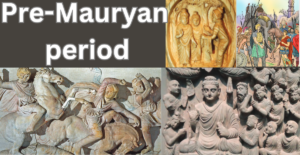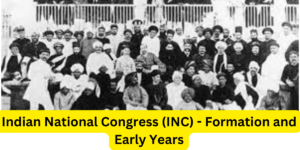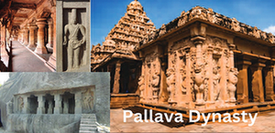Post-Gupta Period
Introduction:
Post-Gupta Period governments were also in power.After the fall of the Guptas, several small kingdoms emerged in north India.The Maithris formed a powerful state in Saurashtra (Gujarat) with Vallabhi as their capital.Agra and Ayodhya created independent autonomy by the Mauryas.The Vakatas restored and established their rule in the western Deccan region.The independent rule was formed by the Pushya Bhutiyas of Thaneswaram on the banks of the River Yamuna and Sutlej in the north.At the same time, it began the rule of the Palas in bengal.The Rashtradas ruled over the southern regions and the Gangetic plains.
Vardhana or Pushyabhuti dynasty:
The Vardhana dynasty was founded by Pushyabhuti.He was the commander-in-chief under the Gupta Empire. Later, due to the fall of the Guptas, he took power and established autonomy.He established his capital city at Dhaneswaram and ruled.After the rule of Pushyabhutri, his son Prabhakara Vardhana (From AD 580 to 605) he came to power.Prabhakara Vardhana fought against the Gurjaras and the Huns and extended his rule to Malava and Gujarat.He married his daughter Rajasree to Kiragavarman of the Maukari dynasty who ruled Kanosi and made Kanosi his ally.After the death of Prabhakaravardhana, his eldest son Rajyavardhana (AD 605-606) ascended the throne.Rajyavardhana was killed by the Gowda king Sasas when he ruled Bengal
Post-Gupta Period-Harsha:
Later, his brother Harshavardhana (at the age of 16) became the king of Daneswaram.Harshavardhana, knowing the weaknesses of the neighbouring princely states, invaded them and annexed them to his empire.Harsha shifted his capital from Daneswaram to Kannosi.Kanosi is a thriving agricultural region of the western Gangetic plain.According to Banner, he sent an ultimatum to the coming states to surrender in an attempt to create an empire.
- Sasanga, the Gowda king who ruled Bengal
- Maitreyas who ruled Over Vallivi
- The Gurjaras who ruled the Purohit region.
- The Chalukya king who ruled the Deccan was Pulikesi II.
- Kings of Sindh, Nepal, Kashmir, Magadha, Otra and Kongagoda.
The king of Kamarupa, who ruled assam, allied with Prakiyotisha, conquered the Kingdom of Gowda and annexed it under his rule.The Vallabhi kingdom became a coalition subsidiary state under the rule of the king.Harsha fought a battle with Pulikesi II, the ruler of the Deccan, and was defeated. Pulikesi received the title of “Parameswara” because he conquered Harsha.The king ruled for about 41 years. His territory consisted of Jalandhar, Kashmir, Nepal, Vallabhi, Assam, Bengal, Bihar, Kannusi, Malwa, Orissa, Punjab and Sindh.In AD 643 and the following AD 647, Emperor Dai-chung sent a delegation to Harsha’s court.
Vardhana Admin:
Harsha’s reign resembled that of the Guptas. His empire built rest houses that provided all the necessary amenities to the poor and took good care of them.During the reign of the king, he collected three kinds of taxes, namely, Baga, Hiranya and Bali.
- Baga – Land Tax
- Hiranya – Tax for farmers and traders
- Bali – the tax given by the people themselves.
The laws for crimes were tougher than those of the Guptas.The independent rulers, collectively known as the ‘Mahasamandas‘, paid homage to Harshavardhana and helped him by providing him with military reinforcements.This played an important role in the expansion of Harshavardhana’s empire.He focused directly on the army and their discipline.His soldiers were known as Sadar and Badar.The officers of the cavalry were known as Brihadeeswarar.The imperialà province was the à villagesà of Bugtià VishyaàBadaka.The history of the king refers to the municipal corporations and local administrations.
| officer | incident |
| Avanti | Chief Minister |
| Simmananda | Commander-in-Chief |
| Kundala | Head of the Palace Guards |
| Skandagupta | king |
| Tirgatvaja | Chief Justice |
| Banu | Head of the Treasury |
| Mahapratihara | Governor of a Province |
| Sarvagathar | Minister of Agriculture |
| Brihadeeswarar | Minister of Commerce |
Vardhana Religion and caste system:
Harsha was a devotee of Lord Shiva till 631 Later, he embraced Buddhism at the insistence of his sister Rajayashree and Yuanchuang.He also prohibited the killing of animals and the eating of meat.In the year AD 643, Harsha convened two Buddhist religious meetings.The first meeting was held in Perspective and the second in Prague.The first meeting held at Kanosi was attended by 20 kings, including Bhaskara Varman, the king of Kamarupathu.Once in five years he convened a Buddhist meeting called the “Mahamoksha Parishad“.According to Yuan Chuang, there were four divisions based on occupation during the reign of the king.Bitter shopkeepers, fishermen, dancers, and sweepers lived outside the city.
Vardhana Art and Literature:
The state spent a quarter of its revenue on harsha literature and culture.Banar, the author of Harsha Charitra and Kadambari, was the court poet of Harsha.The king generously gave an umbrella to promote education. Temples and monasteries were centres of learning.
Post-Gupta Period-Pala Empire:
Origin of the Pala Empire:
The Palas ruled eastern India from the 9th century to the 12th century with Pataliputra as their capital.After the confluence of the Sasas , the king of the Gowda dynasty, who ruled from AD 590 to 625, a number of smaller feudal states emerged.In order to control the conflicts between them, a group came together and appointed gopala (AD 750), a Kshatriya leader, as king for the country.Gopala established the Pala Empire in the ninth century.The empire initially ruled Bihar and Bengal.The Pala Empire extended its rule to Bihar, Bengal and parts of Orissa and Assam for nearly four centuries.
The main rulers are:
Gopala (750–770 AD):
He was the founder of the Pala dynasty.He was elected by the people to put an end toIt expanded control over Bihar and Bengal.
Dharmapala (770–815 AD):
He was involved in a tripartite struggle for Kanauj.Rashtrakuta was defeated by king Dhruva in 815 He received the titles of Parameswara, Paramabhatta and Maharajadhi Raja.He was a great activist of Buddhism. He established a Buddhist monastery called Vikkaraseema in Bhagalpur district of Bihar.
Devapala (A.D. 815–850):
It captured Kamarupa (Assam) and Utkala (Orissa).The Rashtrakuta ruler defeated Amoghavarsha .He donated five villages for the maintenance of the Nalanda University monastery to Bala Buddha Deva, the king of the Shailendra dynasty who ruled Suvarnadeepam.Vikramapalaka, who succeeded Devapala , ruled for a few years and then took up asceticism.Then the chieftains began to run autonomy.During the reigns of rajapala, Gopala III and Vikramapala II, the Pala dynasty began its campaign.
Mahipala I (988 AD):
Mahipala I (AD 1020– 1025 ), son of Vikramapala II.Parts of North and West Bengal were restored.Rajendra Chola, who was invading north India, was stopped in the Ganges.Bala initiated the renaissance of the empire.He ruled for 15 years.
Rambala:
- The last mighty King Bala.If you rule for 53 years. After his death, the Pala dynasty ruled only Magadha.
Religion of the Balas:
The Palas embraced Buddhism and Hinduism.Haribhadra, a Buddhist philosopher, was the guru of Dharmapala to establish the kingdom of the Palas.They followed Mahayana Buddhism. The Palas built notable monasteries such as the Somapura Mahavihara and contributed to the spread of Mahayana Buddhism in various areas.
Preschool Arts and Education:
The Palas invested in education, renovated the Nalanda University, established the Vikramasila University and the Somapura Mahavihara, which were educated not only by Indians but also by foreigners.The Palas built mahaviharas, stupas, chaityas, temples and forts.Notable examples include Nalanda, Vikramasila and Somapura Mahavihara .
Literature:
Atisha, Charaka, Tiloba, Tansyal, Tansri, Zeenamithra, Mukti Mitra, Padmamanavar, Virasansila and Bhakta are scholars of Vikramasila Nalanda University .The philosophical works that appeared during the period of the Palas were the Agama Shastras of Padar and the Nyaya Kundali of Sridharapatta.Ramacharitharam, composed by Sandhyakar Nandi, is a biography of Rama Bala.





Pingback: Rashtrakuta dynasty | Literary|Architecture|Kings